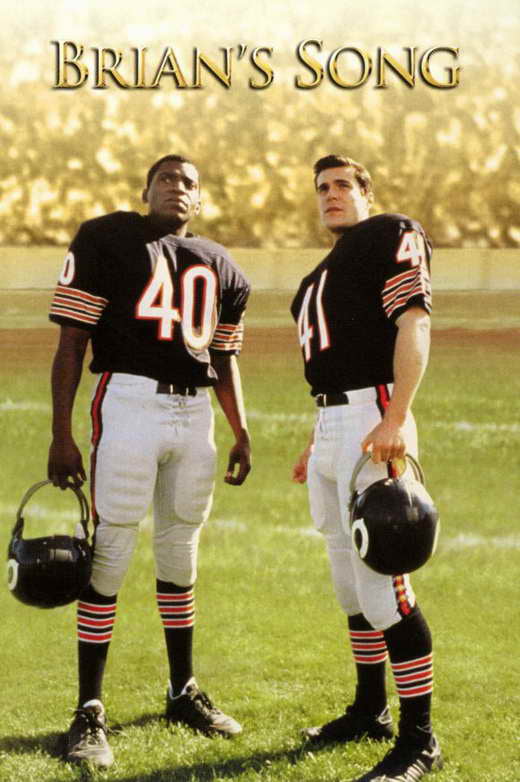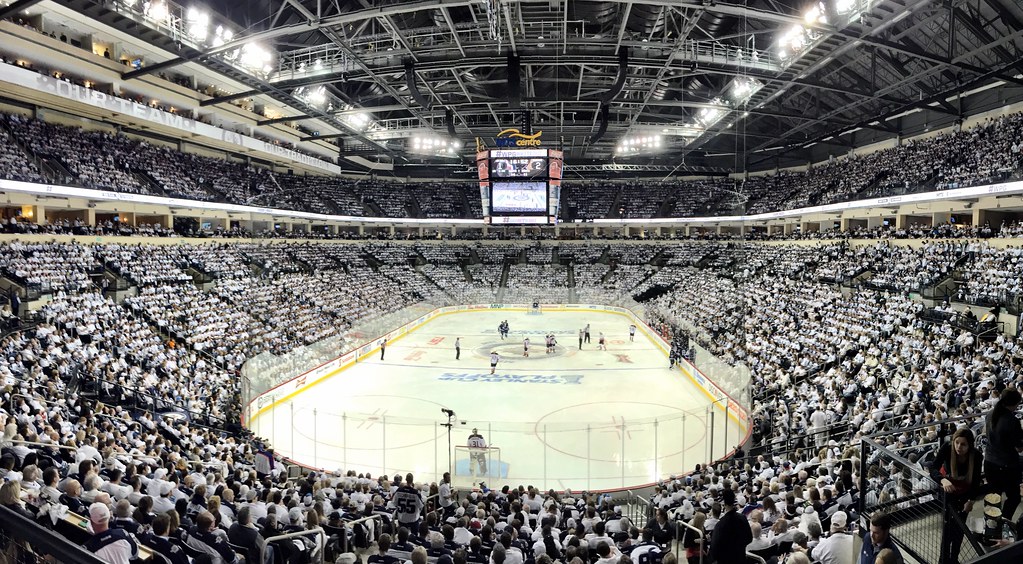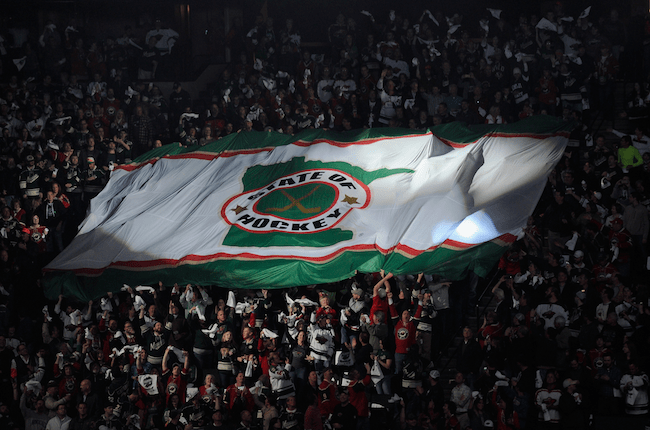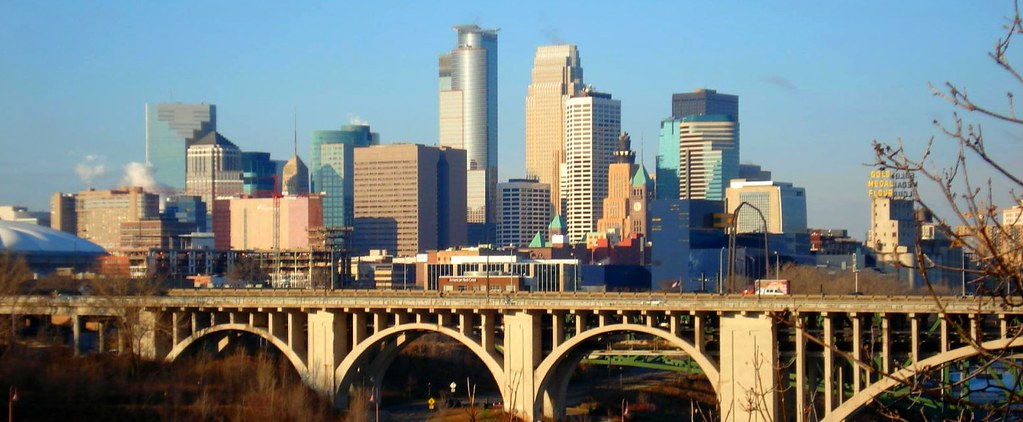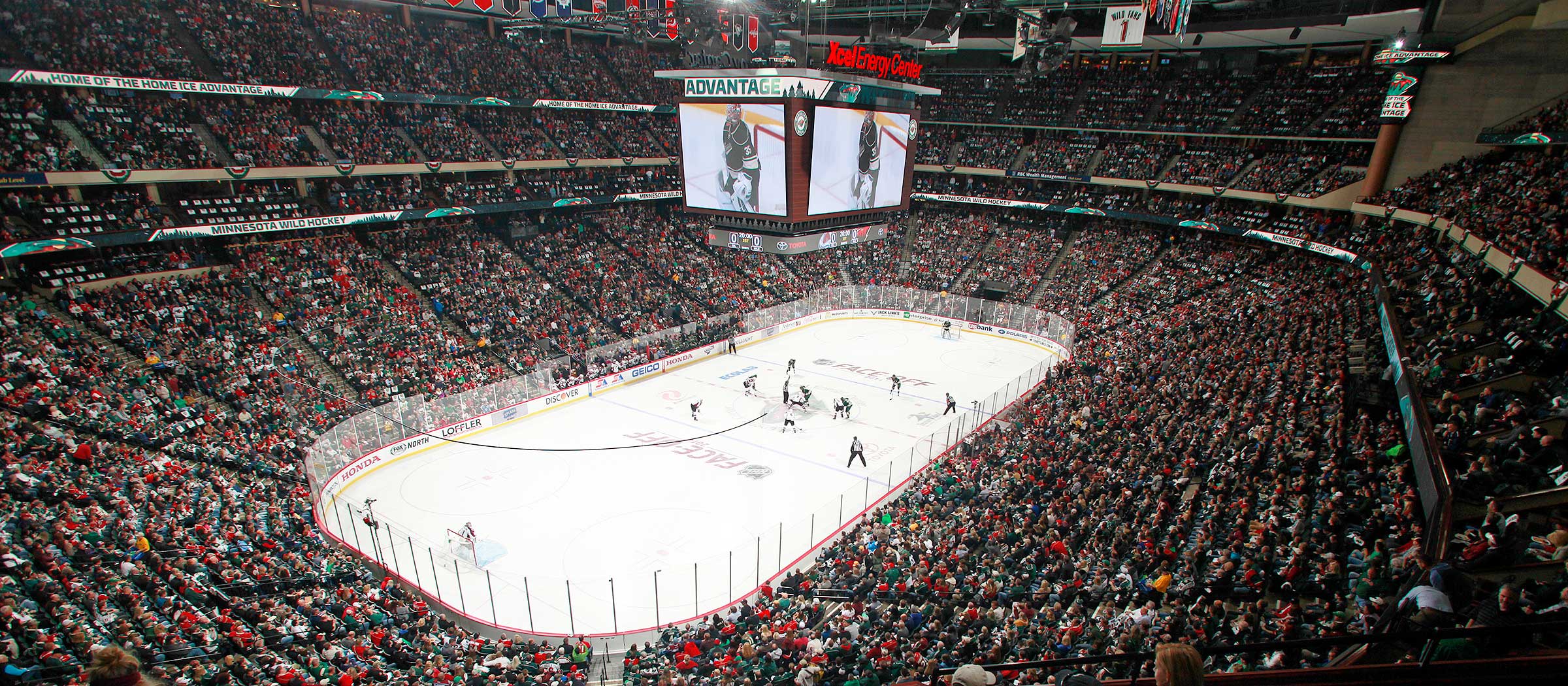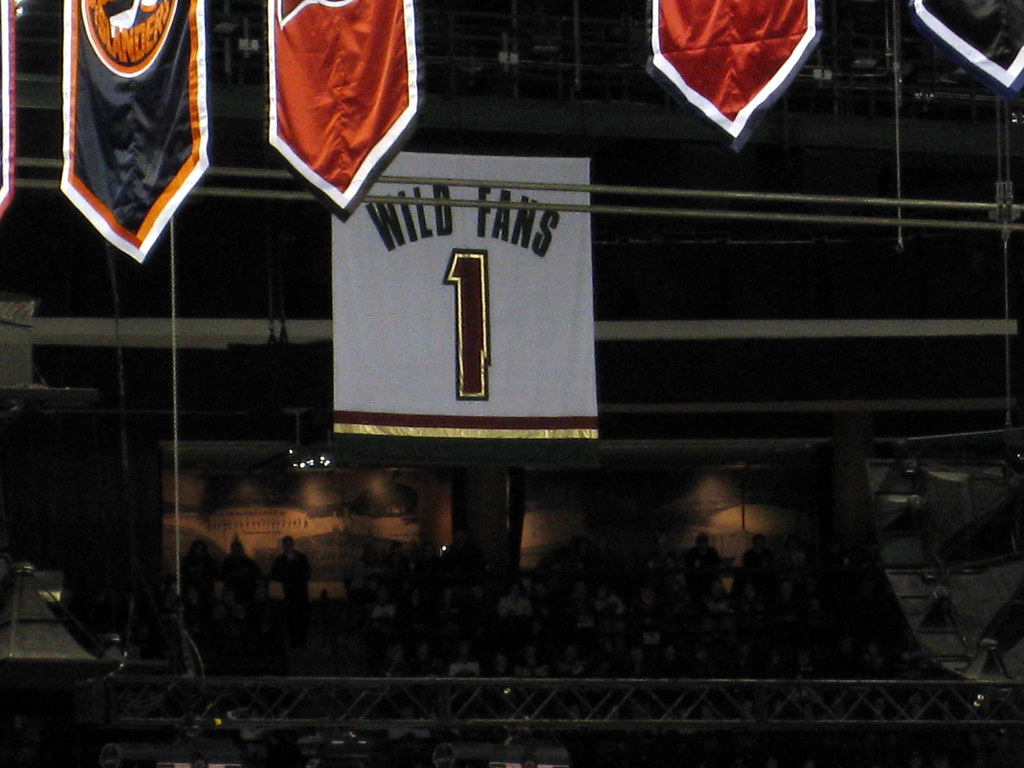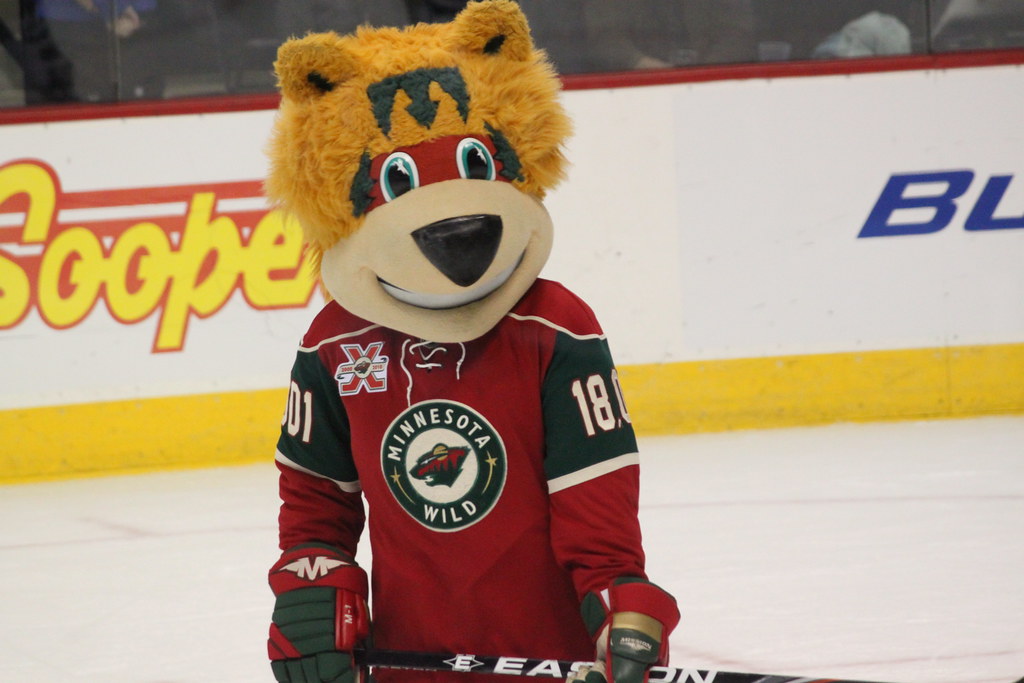The Vikings reached 4 Super Bowls while playing at The Met, while the Twins won Games 1, 2 and 6 of the 1965 World Series there, but lost Game 7 to the Los Angeles Dodgers on a shutout by Sandy Koufax. (So the Twins are 11-1 all-time in World Series home games, but 0-9 on the road.) The Vikings were far more formidable in their ice tray of a stadium, which had no protection from the sun and nothing to block an Arctic blast of wind.
In fact, the Met had one deck along the 3rd base stands and in the right field bleachers, two decks from 1st base to right field and in the left field bleachers, and three decks behind home plate. Somebody once said the stadium looked like an Erector set that a kid was putting together, before his mother called him away to dinner and he never finished it. At 45,919 seats, it had a capacity that was just fine for baseball; but at 48,446, it was too small for the NFL.
Prior to the 1961 arrivals of the Twins and Vikings, the Met hosted the Minneapolis Millers from 1956 to 1960, and 5 NFL games over the same stretch, including 4 "home games" for the Packers. (Viking fans may be sickened over that, but at least University of Minnesota fans can take heart in the University of Wisconsin never having played there.)
The experiments worked: The Met, built equidistant from the downtowns of Minneapolis and St. Paul, in the southern suburb of Bloomington, was awarded the MLB and NFL teams, and Midway Stadium, built in 1957 as the new home of the St. Paul Saints (at 1000 N. Snelling Avenue in the city of St. Paul, also roughly equidistant from the two downtowns), struck out, and was used as a practice field by the Vikings before being demolished in 1981.
The NHL's Minnesota North Stars played at the adjoining Metropolitan Sports Center (or Met Center) from 1967 to 1993, before they were moved to become the Dallas Stars by owner Norm Green, earning him the nickname Norm Greed. The Stars reached the Stanley Cup Finals in 1981 and 1991, but never won the Cup until 1999 when they were in Dallas. Larry Holmes successfully defended the Heavyweight Championship of the World at the Met Center on July 7, 1980, knocking out Minnesota native Scott LeDoux.
The Met Center, with Metropolitan Stadium in the background
The Beatles played at Metropolitan Stadium on August 21, 1965 -- making it 1 of only 3 facilities to host an All-Star Game, a Finals and a Beatles concert in the same year. (The others were the Boston Garden and Maple Leaf Gardens in 1964.) Elvis Presley sang at the Met Center on November 5, 1971 and October 17, 1976.
8000 Cedar Avenue South, at 80th Street -- near the airport, although legends of planes being an issue, as with Shea Stadium and Citi Field, seem to be absent. A street named Killebrew Drive, and the original location of home plate, have been preserved. A 45-minute ride on the Number 55 light rail (MOA station).
* Site of Nicollet Park. Home of the Millers from 1912 to 1955, it was one of the most historic minor-league parks, home to Ted Williams and Willie Mays before they reached the majors. With the Met nearing completion, its last game was Game 7 of the 1955 Junior World Series, in which the Millers beat the International League Champion Rochester Red Wings.
A few early NFL games were played there in the 1920s, including home games by a team a team known as the Minneapolis Marines and the Minneapolis Red Jackets. A bank is now on the site. Nicollet and Blaisdell Avenues, 30th and 31st Streets. Number 465 bus.
* Site of Lexington Park. Home of the Saints from 1897 to 1956, it wasn't nearly as well regarded, although it did close with a Saints win over the arch-rival Millers. The site is now occupied by retail outlets. Lexington Parkway, University Avenue, Fuller & Dunlap Streets.
* Target Center. Separated from Target Field by I-394 and 2nd Avenue, this arena has been home to the NBA's Minnesota Timberwolves since the team debuted shortly after its 1989 opening. The T-Wolves have only made the Western Conference Finals once, and are probably best known as the team Kevin Garnett and GM (and Minnesota native) Kevin McHale couldn't get over the hump, before Garnett went to McHale's former team, the Boston Celtics.
The Minnesota Lynx also play here, and have become the WNBA's answer to the San Antonio Spurs, winning league titles in odd-numbered years: 2011, 2013, 2015 and 2017. 600 N. 1st Avenue at 6th Street.
* University of Minnesota. Coming from downtown, you would take the Green Line light rail to Stadium Village stop to reach the UM campus. Huntington Bank Stadium, known until this year as TCF Bank Stadium, home of the Golden Gophers, is at 420 SE 23rd Avenue.
The stadium opened in 2009, allowing the University of Minnesota Golden Gophers to play home games on campus as they did at Memorial Stadium from 1924 to 1981. Their alumni were sick of playing in the cold, so when the Metrodome opened for the Twins and Vikings in 1982, they wanted in (figuratively and literally). But, even during winning seasons (which have been few and far between since the 1960s), attendance was lousy. So an on-campus facility was built.
Before moving in for the 2014 and '15 seasons, the Vikings played a home game there in 2010, following a snow-caused collapse of the Metrodome roof. The Vikings lost to the Chicago Bears, and it turned out to be Brett Favre's last NFL game. It's also hosted an outdoor game for UM hockey, and on February 21, 2016, it played host to a 6-1 win by the Wild over the Chicago Blackhawks. It hosted a match between soccer teams Manchester City of England and Olympiacos of Athens, Greece.
It hosted a match between soccer teams Manchester City of England and Olympiacos of Athens, Greece, and Major League Soccer's Minnesota Wild began play there in 2017.
Across Oak Street from the open west end of the stadium are the basketball and hockey venues. Williams Arena opened in 1928, has hosted UM basketball ever since, UM hockey from then until 1993, and the 1951 NCAA Final Four (Kentucky beating Kansas State). It hosted the Frozen Four in 1958 and 1966.
Mariucci Arena opened in 1993, and has hosted UM hockey ever since. The Golden Gophers have won 5 National Championships: 1974, 1976, 1979, 2002 and 2003. Memorial Stadium was across University Avenue from Williams Arena. The UM alumni center and swimming venue were built on the site.
Williams Arena and Mariucci Arena
* Site of Minneapolis Auditorium. Built in 1927, from 1947 to 1960 this was the home of the Minneapolis Lakers – and, as Minnesota is "the Land of 10,000 Lakes" (11,842, to be exact), now you know why a team in Los Angeles is named the Lakers. (The old Utah Jazz coach Frank Layden said his team and the Lakers should switch names, due to L.A.'s "West Coast jazz" scene and the Great Salt Lake: "Los Angeles Jazz" and "Utah Lakers" would both make more sense than their current names.)
The Lakers won the National Basketball League Championship in 1948, then moved into the NBA and won the Championship in 1949, 1950, 1952, 1953 and 1954. In fact, until the Celtics overtook them in 1963, the Minneapolis Lakers were the most successful team in NBA history, and have still won more World Championships than all the other Minnesota major league teams combined: Lakers 5, Twins 2, the rest a total of 0. (Unless you count the Lynx, who make it Lakers 5, everybody else 5.)
They were led by their enormous (for the time, 6-foot-10, 270-pound) center, the bespectacled (that’s right, he wore glasses, not goggles, on the court) Number 99, George Mikan. The arrival of the 24-second shot clock for the 1954-55 season pretty much ended their run, although rookie Elgin Baylor did help them reach the Finals again in 1959.
Elvis sang there early in his career, on May 13, 1956. The Auditorium was demolished in 1989, and the Minneapolis Convention Center was built on the site. 1301 2nd Ave. South, at 12th Street. Within walking distance of Target Field, Target Center and the Metrodome.
* Minneapolis Armory. Built in 1936 for the Minnesota National Guard, the Lakers used it as their home court part-time throughout their Minneapolis tenure, and full-time in their final season in Minneapolis, 1959-60. Ironically, the owner of the Lakers who moved them to Los Angeles was Bob Short – who later moved the "new" Washington Senators, the team established to replace the team that moved to become the Twins.
It was later the video-filming site for Minneapolis native Prince's "1999" and Aerosmith's "I Don't Want to Miss a Thing." It's been kept standing as a parking lot. 500 6th Street, downtown.
* Minnesota United. Originally NSC Minnesota and then the Minnesota Stars, they are not, oddly enough, named in tribute to Manchester United, but for UnitedHealth Group, which like the team, is owned by Bill McGuire.
From its 2010 inception through 2016, except for the occasional game moved to the Metrodome for more seats, MNUFC -- never "MUFC," like Manchester United -- played its home games at a 10,000-seat stadium at the National Sports Center in Blaine, about 15 miles north of downtown Minneapolis. 1700 105th Avenue NE at Davenport Street NE. Hard to reach by public transportation: You'll need at least 2 buses, and to then walk a mile and a half.
The team has been promoted from the new North American Soccer League to Major League Soccer, and just ended its 1st season at that level. For 2019, they are planning on opening a new 19,400-seat, soccer-specific stadium, Allianz Field, in St. Paul, at about 400 N. Snelling Avenue, at the intersection of St. Anthony Avenue, just off I-94/U.S. 12/U.S. 52, about a mile and a half south of the site of old Midway Stadium. Green Line light rail to Snelling Avenue.
* Duluth. Minnesota's largest city outside the Twin Cities region is 155 miles to the northeast, at the western edge of Lake Superior. It was home to the State's 1st NFL team. They played the 1923, '24 and '25 team as the Duluth Kelleys, because they were sponsored by the Kelley-Duluth Hardware Store. They played the 1926 and '27 season as the Duluth Eskimos, and featured Hall-of-Famers Ernie Nevers and John "Johnny Blood" McNally.
They played at Athletic Park, which opened in 1903 and served as home of the minor-league Duluth White Sox from 1903 to 1916, and the Duluth Dukes from 1934 to 1940. It seated 6,000, and was replaced by the 4,2000-seat Wade Stadium on the same site in 1941. That was home to the Dukes until 1970, to a new Duluth-Superior Dukes from 1993 to 2002, and to the Duluth Huskies since 2003. In their various leagues, the Dukes/Huskies won Pennants in 1937, 1956, 1961, 1963, 1969, 1970 and 1997. 101 N. 35th Avenue West, about 3 miles southwest of downtown.
The 6,764-seat Duluth Entertainment Center hosted the hockey team at the University of Minnesota at Duluth from 1966 to 2010, one of the better hockey programs (if not as accomplished as their cousins down in Minneapolis). It also hosted the Frozen Four in 1968 and 1981, and Elvis on October 16, 1976 and April 29, 1977.
The 6,726-seat Amsoil Arena -- smaller, but much more convenient -- was built next-door in 2010, and UMD moved in for the 2010-11 season, and went on to win that season's National Championship. Both buildings are downtown, and have an address of 350 Harbor Drive.
* Museums. The Twin Cities are very artsy, and have their share of museums, including 1 of the 5 most-visited modern art museums in the country, the Walker Art Center, at 1750 Hennepin Avenue. Number 4, 6, 12 or 25 bus. The Minneapolis Institute of Arts is at 2400 3rd Avenue South. Number 17 bus, then walk 2 blocks east on 24th Street. The Science Museum of Minnesota is at 120 W. Kellogg Blvd. in St. Paul, across from the Xcel Center.
Fort Snelling, originally Fort Saint Anthony, was established by the U.S. Army in 1819, where the Mississippi and Minnesota rivers meet, to guard the Upper Midwest. It served as an Army post until World War II. It is now a museum, with historical demonstrations based on its entire history, from the post-War of 1812 period to the Civil War, from the Indian Wars to the World Wars. 101 Lakeview Avenue in St. Paul, across from the airport. An hour's ride on the Blue light rail.
Minnesota is famous for Presidential candidates that don't win. Governor Harold Stassen failed to get the Republican nomination in 1948, and then ran several more times, becoming, pardon the choice of words, a running joke. Senator Eugene McCarthy opposed Lyndon Johnson in the Democratic Primaries in 1968, but lost his momentum when Robert Kennedy got into the race and LBJ got out, then ran in 1976 as a 3rd-party candidate and got 1 percent of the popular vote.
Vice President Walter Mondale was the Democratic nominee in 1984, losing every State
butMinnesota in his loss to Ronald Reagan. In the 2012 election cycle, the moderate former Governor Tim Pawlenty and the completely batty Congresswoman Michele Bachmann ran, and neither got anywhere.
Most notable is Hubert Horatio Humphrey. Elected Mayor of Minneapolis in 1945 and 1947, he became known for fighting organized crime, which put a price on his head, a price it was unable to pay off. In 1948, while running for the U.S. Senate, he gave a speech at the Democratic Convention, supporting a civil rights plank in the party platform, a movement which culminated in his guiding the Civil Rights Act of 1964 through the Senate as Majority Whip. He ran for the Democratic nomination for President in 1960, but lost to John F. Kennedy, then was elected LBJ's Vice President in 1964.
He won the nomination in 1968, but lost to Richard Nixon by a hair. He returned to the Senate in 1970, and ran for President again in 1972, but lost the nomination to George McGovern. He might have run again in 1976 had his health not failed, as cancer killed him in 1978 at age 66. His wife Muriel briefly held his Senate seat.
Not having been President (he's come closer than any other Minnesotan ever has), he has no Presidential Library, but there is the Hubert H. Humphrey School of Public Affairs at the University of Minnesota, 301 19th Avenue South, only a short walk from the Dome that would be named for him. Hubert and Muriel are laid to rest in Lakewood Cemetery, 3600 Hennepin Avenue. Number 6 bus.
The tallest building in Minnesota is the IDS Center, at 80 South 8th Street at Marquette Avenue, rising 792 feet high. The tallest in the State outside Minneapolis is Wells Fargo Place, at 30 East 7th Street at Cedar Street in St. Paul, 472 feet.
Nicollet Mall is a pedestrians-only shopping center that stretches from 2nd to 13th Streets downtown. At 7th Street, in front of Macy's, in roughly the same location that Mary Tyler Moore as Mary Richards threw her hat in the air in the opening to
The Mary Tyler Moore Show, is a statue of "Mare" doing that. However, the show had no location shots in Minneapolis.
The dedication: Bronze Mary at left, Real Mary at right
Mary's statue was the 1st in a series commissioned by TV Land that now includes Jackie Gleason as Ralph Kramden in
The Honeymooners outside Port Authority Bus Terminal, Henry Winkler in
Happy Days (a statue known as the Bronze Fonz) in Milwaukee, Bob Newhart as Bob Hartley in
The Bob Newhart Show in Chicago, Andy Griffith and Ron Howard as Andy and Opie Taylor in
The Andy Griffith Show in Raleigh, Elizabeth Montgomery as Samantha Stephens in the "witch city" of Salem, Massachusetts (even though
Bewitched was set in Westport, Connecticut), and Elvis Presley outside the Blaisdell Center in Honolulu where he played the concert for his 1973 TV special.
The Many Loves of Dobie Gillis, Little House On the Prairie and
Orphan Black were set in Minnesota, although not shot there.
The Adventures of Rocky & Bullwinkle was set in the fictional town of Frostbite Falls, Minnesota. Of course, being animated, it had no location shots.
The sitcom
Coach, which aired on ABC from 1989 to 1996, was set at Minnesota State University. At the time, there was not a real college with that name. But in 1999, Mankato State University was renamed Minnesota State University, Mankato; and in 2000, Moorhead State University became Minnesota State University, Moorhead.
The University of Minnesota was originally a model for the school on the show, but withdrew its support: Although some game action clearly shows the maroon and gold of the Golden Gophers, the uniforms shown in most scenes were light purple and gold. In one Season 1 episode, the Gophers are specifically mentioned as one of the Screaming Eagles' opponents, suggesting that Minnesota State might have been in the Big Ten. Show creator Barry Kemp is a graduate of the University of Iowa -- like Wisconsin, a major rival of the Gophers -- and most of the exterior shots you see of the campus were filmed there. In addition, the main character, Hayden Fox, was named after then-Iowa coach Hayden Fry. No scenes were actually shot in Minnesota, not even Hayden's oft-snowy lake house.
Movies filmed in Minnesota include the baseball films
Little Big League and
Major League: Back to the Minors, the George Clooney 1920s football film
Leatherheads,
The Bishop's Wife (1947, later remade as
The Preacher's Wife),
Airport (the 1970 film that helped inspire the decade's disaster film craze), the Western
The Great Northfield, Minnesota Raid, the
Grumpy Old Men movies, Kevin Smith's
Mallrats,
Juno, and, most memorably due to its use of the Minnesota accent, the Coen Brothers'
Fargo (which now has a TV version shot there).
St. Paul is the capital of the State of Minnesota. The Capitol Building is at University Avenue and Capital Blvd. It's a half-hour ride from downtown on the Number 94 bus (named because most of its route is on I-94).
*
Bob Wood, a native of Kalamazoo, Michigan, and a graduate of Michigan State University, wrote a pair of sports travel guides:
Dodger Dogs to Fenway Franks, about his 1985 trip to all 26 stadiums then in MLB; and
Big Ten Country, about his 1988 trip to all the Big Ten campuses and stadiums. (Penn State, Nebraska, and soon-to-be members Rutgers and Maryland were not yet in the league).
The Metrodome was the only stadium that featured in both books, although if either were updated to reflect current reality, it would feature in neither. In
Big Ten Country, Wood said, "Now, don't get me wrong. It's not that I don't like Minneapolis. How can you not like Minneapolis?... No, Minneapolis is lovely. It's the Metrodome that sucks!"

